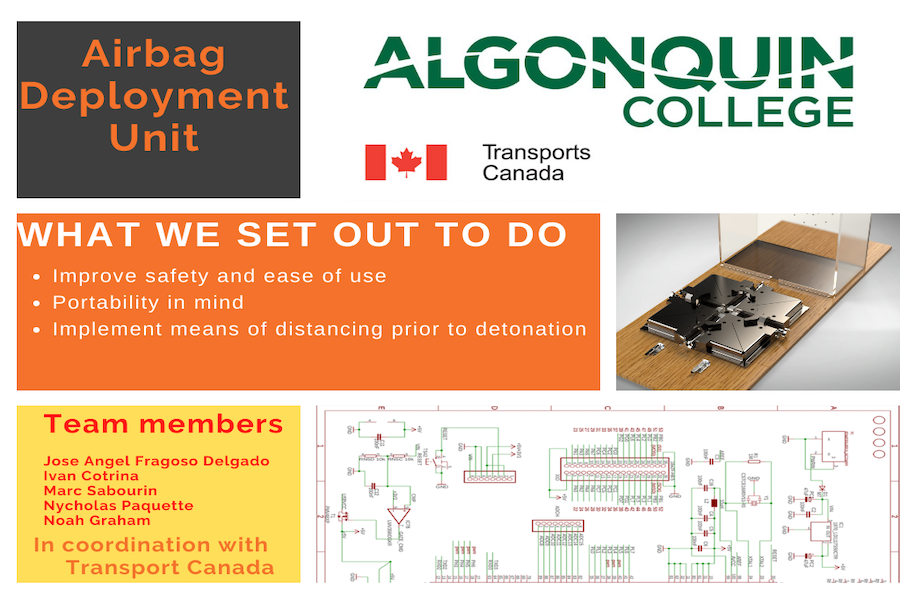Airbag Deployment Unit
Posted on Monday, March 28th, 2022

| Client | Trevor Lehouillier, Transport Canada |
| Professor(s) | Laura McHugh, Bijan Borzou |
| Program | Electrical/Mechanical Engineering Technology |
| Students | José Angel Fragoso Delgado Ivan Cotrina Marc Sabourin Nycholas Paquette Noah Graham |
Project Description:
The Transport Canada Airbag Deployment Unit is designed to detonate pyrotechnic devices in a safe and controlled environment.
It uses a custom vice designed to secure devices such as driver airbags, passenger airbags, and seat belt pre-tensioners. This is on top of a Lista workbench and covered by a polycarbonate enclosure to protect people and the environment from possible debris escaping the ignitors.
The deployment unit uses an electrical circuit to ensure that no accidental detonations occur and that the device in question is properly secure in the vice.
The Defect-Related Information on Vehicles and Equipment (D.R.I.V.E) analyses transportation-related accidents and tries to determine the cause so that it can be prevented in the future. Many severe accidents deploy airbags, and sometimes, they can be faulty and injure the vehicle’s occupants more than help them. Transport Canada also receives many unexploded ignitors from accident vehicles. Therefore, they need a safe way to test and/or dispose of them.
Previously, the D.R.I.V.E. team at Transport Canada would attach airbag ignitors to a camera tripod and use long wires to send 9V from a D-battery to detonate the ignitors outside. This was not very safe and could only be done outside.
For our final project, Trevor Lehouillier from Transport Canada tasked us, Project Team F, with solving this issue at the beginning of the fall 2021 term.
The idea for the airbag deployment unit was brought to us by Algonquin College as a collaboration initiative with Transport Canada’s Recall and Defect Department to improve the safety and ease of detonation of vehicular pyrotechnic devices such as airbags, knee bolsters, and seatbelt pre-tensioners.
In most cases, these devices are very safe, designed to detonate within the confines of the cabin of an automobile, and meant to protect the vehicle passengers from serious injuries during motor vehicle accidents. In Transport Canada’s case, the recall and defect investigators are dealing with pyrotechnic devices that have undergone failure during an accident or have been involved in a manufacturer recall by which, their safety standards can no longer be assumed, and they must therefore be treated as volatile and unpredictable explosive devices.
The requirements revolve around increasing the safety precautions and procedures used to investigate these devices by minimizing the risk to the investigative teams. The essential needs expressed by the Recall and Defect Department team focus on allowing for rapid, safe, and efficient detonations all while accounting for unpredictability.
The reasoning for increased handling discretion, as explained by a member of the Transport Canada team, evolved from investigation report data demonstrating evermore unpredictable circumstances of passenger deaths due to minor automobile accidents. Incidents that investigators concluded should have resulted in minimal harm to passengers and no loss of life in which pyrotechnic detonations have been deemed the cause of death due to shrapnel and excessive explosive forces.
The initial information supplied to the project team was conducive to justifying an in-depth exploration of procedure re-evaluation.
Short Description:
An Airbag Deployment Unit designed with the purpose of disposal and Product testing of airbags and Pyrotechnic devices for Transport Canada to ensure Canadian vehicles are safe and verify these safety products function to manufacturers specifications
Video Presentation
Gallery
 |
|
 |
 |
 |
 |